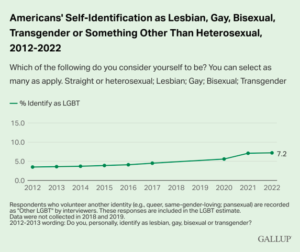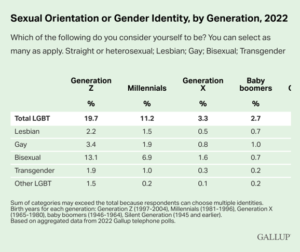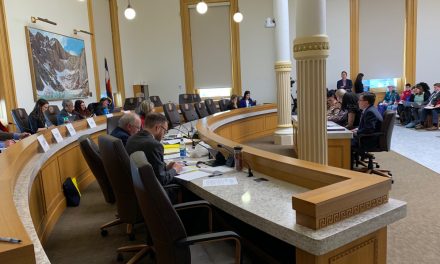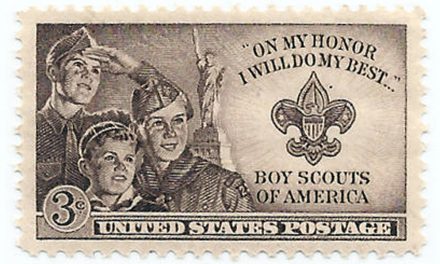A new survey shows 7.2% of U.S. adults identify as lesbian, gay, bisexual, transgender, or “something other than heterosexual.” The number of adults who claim these identities has more than doubled since 2012, up from 3.5%, when Gallup first began this survey.
The research from Gallup also shows 19.7% of adult members of Generation Z, those who were between 18 and 25 years old in 2022, identify as L, G, B, or T. The global analytics firm compared that number to other generational cohorts, saying, “The rate is 11.2% among millennials and 3.3% or less among older generations.”
1.2% of Millennials and 3.3% of Generation Z identify as “transgender” or “other LGBT” (whatever that means). Again, the percentage drops precipitously with older groups, as only 0.4% of Generation X and Baby Boomers identify this way.
The biggest jump, by far, has been those who identify as “bisexual,” with 4.2% of U.S. adults claiming that label. Among Gen Z, 13.1% identify this way.
Here is the Gallup chart showing the change over time for all adults who identify as “Lesbian, Gay, Bisexual, Transgender or Something Other Than Heterosexual”:

That overall percent of adults could rise even further, if such sexual identification continues at the same rate among Generation Z adolescents and teens as they reach adulthood.
This Gallup graphic compares the different age cohorts:

So what’s causing such a large jump in adults who identify this way?
Some LGBT-identified individuals claim the numbers have always been higher than the usual estimates of 2%-4%, arguing that society’s growing acceptance and celebration of homosexuality and transgenderism have just given more people the freedom to “come out” and “be who they really are.”
But there are probably other factors driving this trend. Here are just a few of them.
A Socio-Political Identity
The Center for the Study of Partisanship and Ideology (CSPI) noted last year that while 20% of those under 30 might identify as lesbian, gay or bisexual, “When we look at homosexual behavior, we find that it has grown much less rapidly than LGBT identification.”
So young adults may identify as lesbian, gay or bisexual, but they don’t necessarily have same-sex sexual relationships.
In the CSPI report “Born This Way? The Rise of LGBT as a Social and Political Identity,” the group noted, “Left-wing Americans are significantly more likely to be LGBT than those on the right.” They also note that that “52% of students taking highly political majors such as race or gender studies identify as LGBT, compared to 25% among students overall.”
CSPI asks the question, “Is this because such people are more liberated, or because LGBT is now a kind of political identity?”
They suggest a socio-political motive for “whites and the university educated” but add, “This is less likely to account for the rise in LGBT identity among young minorities and those without a college education.”
The group concludes: “Overall, the data suggest that while there has been an increase in same-sex behavior in recent years, sociopolitical factors likely explain most of the rise in LGBT identity.”
The Influence of Education
LGBT activists and their allies began promoting teaching about homosexuality and transgenderism to school children about 40 years ago. Controversial, gay-themed picture books like Heather Has Two Mommies, Jenny Lives with Eric and Marten and Daddy’s Roommate began showing up in classrooms and school libraries in the 1980s.
About the same time, LGBT activist groups and their allies began introducing school-based groups like Los Angeles Unified School District’s Project 10 and the Gay-Straight Alliance. These were designed to support LGBT-identified students and to fight bullying and harassment, but also served to get students and teachers talking about LGBT issues.
Activist groups, like the Southern Poverty Law Center, the Human Rights Campaign and the National Education Association also began producing supplemental classroom materials with LGBT themes for teachers and schools.
In 2011, California passed the “FAIR Education Act,” requiring schools to teach about LGBT-identified individuals in all history and social science classes, from kindergarten through twelfth grade. Other states, such as Colorado, Illinois, Maryland, New Jersey and Oregon, followed California’s lead.
Students across the country have been learning about “sexual orientation,” “gender identity” and “gender expression” – often as early as kindergarten. It’s no wonder that many of them take on sexual identities or experiment with same-sex sexual behaviors.
Social Contagion
Dr. Lisa Littman, who trained in obstetrics and gynecology, was an Assistant Professor in the Department of Behavioral and Social Sciences at the Brown University School of Public Health. She told Quillete that she grew interested in studying gender dysphoria when she saw that teen girls “from the same friend group began announcing transgender identities on social media, one after the other, on a scale that greatly exceeded expected numbers.”
She said, “I reviewed the scientific literature about gender dysphoria and peer contagion and I explored the social media environment around gender and transgender identity.”
Littman began talking with parents and published a research paper, “Rapid-onset gender dysphoria in adolescents and young adults: A study of parental reports.” Littman coined the term “rapid-onset gender dysphoria” (ROGD) to describe the phenomenon, “whereby teens and young adults who did not exhibit childhood signs of gender issues appeared to suddenly identify as transgender.”
She found that many of the young women suffered from mental health issues, neurodevelopmental disabilities and/or trauma. She also found “social contagion and peer influences” were potential factors “and the social-media environment seemed conducive to the mechanisms of peer contagion.”
Others have picked up her idea, including comedian and political writer Bill Maher, host of the HBO political talk show Real Time with Bill Maher. He noted the rise in self identifying as L, G, B, or T, and said, “If we follow this trajectory, we will all be gay in 2054.”
The Babylon Bee also joked about the Gallup results, highlighting the promotion of LGBT issues in entertainment and social media. They featured a “sociologist” saying,
We can’t begin to explain why young, impressionable kids who are desperate for popularity and affirmation are suddenly choosing to become members of the most popular and affirmed group in human history.
Every single movie, TV show, corporation, TikTok influencer, YouTuber, public school teacher, pop star and Hollywood star in the country openly promotes and celebrates this group. Why on earth would teenagers want to be a part of that? It must be biology.
One in five Gen Z adults identifying as transgender or homosexual is certainly a result of these factors – and others, as every area of society is encouraging these sexual identities. In the face of this pressure, it’s important for the church to be firm in teaching God’s design for relationships, sexuality and marriage and for Christians to live lives that demonstrate the goodness of this.
In addition, as troubled young people realize that homosexuality and transgenderism don’t fulfill their deepest needs, we can pray that they will find better answers through faith in Jesus. And when those caught in these false identities come to faith, the church will need to be equipped to come along side sexually and relational broken people with grace, healing and discipleship.
Related articles and resources:
Are Christian Millennials Increasingly LGBTQ? A New Poll Gets It Very Wrong
Gallup and Major Media Report LGBT Identity is Growing. Is That Really a Thing?
Parents in Virginia Pushing Back Against Library Books that Confuse and Sexualize Children
Resources When Your Child Encounters LGBT Ideology at School
Photo from Shutterstock.






